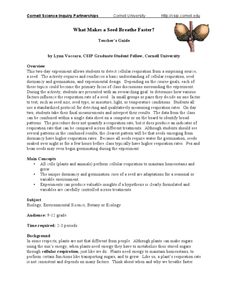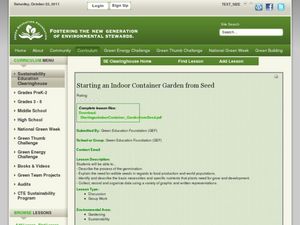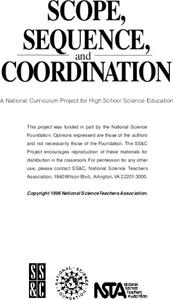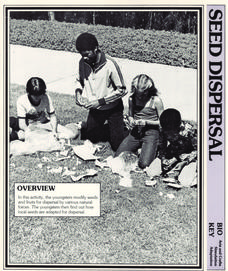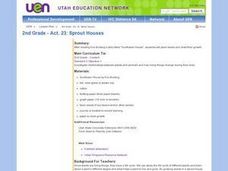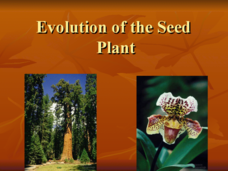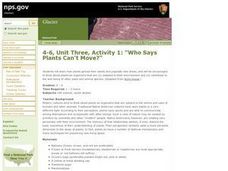Curated OER
What Makes a Seed Breathe Faster?
Here's a five-star lesson plan in which inquisitors conduct sophisticated experimentation with cellular respiration in plant seeds. Placing seeds in a closed system they measure the amount carbon dioxide produced and relate it to...
Curated OER
How Does Your Garden Grow?
Young gardners read and listen to books about seeds, plants, and the growing process. They plant seeds in plastic cups to observe the process of root-growing and plant formation. The whole class walks through a field to collect seeds...
Curated OER
Jeopardy Game - Science
Used in an upper elementary classroom, this presentation could be a center activity or a whole-group experience. This is a great way to review a variety of scientific topics. There are questions relating to the planets, rock formations,...
Curated OER
All About Seeds!
How do fruits relate to flowers and seeds? Identify the seeds and their purpose with a coloring activity for kindergartners. Once they color the seeds of apples, bananas, and peas (among others), kids get hands-on experience with bean...
Curated OER
Flower Power
Determine which plants are flowering plants with a helpful lab sheet. Kids first observe illustrations of different plants, such as a carnation and a fern, then decide which plants produce flowers, spores, or cones. Use magazine pictures...
Curated OER
Starting an Indoor Container Garden from Seed
Students create an indoor container garden. In this container garden lesson, students explore seed germination. Students discuss edible seeds.
Curated OER
Amazing Seeds
Three cute activities introduce youngsters to seeds and roots. In the first activity, various soaked seeds are placed in a glass so that the direction of root growth can be observed. In the second, a bag of seeds is filled with water and...
Curated OER
Classification Schemes
Junior biologists journey through the hiearchy of living things with these activites. Using a dichotomous key, they identify common algae, plants, and fish. They design their own key for a mixture of seeds and a collection of...
Curated OER
Plant Diversity
Here is an all-encompassing overview of the plant kingdom! In this worksheet, beginning botanists describe characteristics of the four different plant phyla, explain various life cycles, differentiate between monocots and dicots, and...
Curated OER
Sorting Things Out
Written to examine seeds that grow in Kansas, you can adapt this lesson to anywhere you live. Learners sort a mixture of five different seeds to by any characteristic of their choice. When your budding scientists are exploring the life...
Curated OER
Seed Swapping
Here is a fabulous, cross-curicular lesson on seeds. Elements of science, writing, math, agricultural practices, and art are all brought into this incredibly thorough plan. Additionally, a fun whole-class game is presented, and there is...
Curated OER
Seed Dispersal
Students disperse seeds. In this Science instructional activity, students experiment with various ways to naturally disperse seeds. Students evaluate the effectiveness of the various ways to disperse seeds.
Curated OER
Let's Grow Plants!
Students read and dramatize the stories "The Tiny Seed" and "The Carrot Seed" as an introduction to seeds and what they become. They work in small groups to plant their own seeds and over the span of a week (+ or -)students keep track of...
Curated OER
Plantable Pulp Cards
What a great way to give a gift that keeps on giving! These homemade plantable cards are not only beautiful, but can be planted into the ground to sprout in the right season. Incorporate this project in a science unit, or for a Mother's...
Curated OER
2nd Grade - Act. 23: Sprout Houses
Read the story "Sunflower House," by Eve Bunting with your 2nd graders to investigate the relationships between plants and animals. They will discover how living things change during their lives by creating their own sprout houses....
Curated OER
Evolution of the Seed Plant
Adaptations of the plant to develop gametes best suited to different pollination atyles are detailed, The conditions needed by Sporophytes and gametophytes of different sizes are detailed, along with the development of the seed...
Curated OER
Seeds in Flight Information Sheet
Seeds in flight are amazing things. Hand out a great information sheet for learners to read. They'll discover facts about seeds, why they spread, and examples of how different seeds get from here to there.
Curated OER
Plant Seeds
The concepts of a year, and the changing of the seasons are very important concepts to reinforce with young learners. Here, pre-kindergartners and kindergartners begin to understand the concept of one year, the passing of time, and the...
Curated OER
Seed Dispersal
Pupils explore seed dispersal by designing their own wind dispersed seed structure. Using one piece of paper and a box fan, they construct a seed dispersal structure, record the distance their seed travels, and answer discussion questions.
Curated OER
Retelling the Tiny Seed
Here is a very age appropriate idea that can be stretched, modified, or used as is. Learners review plant parts, discuss pollination, read the story The Tiny Seed, and write a retell sentence. Their sentences describe to way a seed...
Curated OER
Garden in a Glove
Students observe the life cycle of a plant in a glove. For this life cycle lesson, students read and discuss the life cycle of a plant. Students then plant seeds in a clear plastic glove and record their observations.
Curated OER
Who Says Plants Can't Move?
Learners discover how plants spread their seeds using other plants and animals. In this plant lesson, students role play different plants and how their seeds travel. Learners then have a class discussion to ensure their understanding.
Curated OER
Will It Grow?
Fifth graders conduct experiments involving plants. In this science lesson, 5th graders design an experiment involving plants. Students use the scientific method to design their experiments.
Curated OER
Parts of the Plants that we Eat
First graders study plants and their parts to see what parts are edible. In this plant lesson students are assigned plant parts and they are to put them in the right category.


